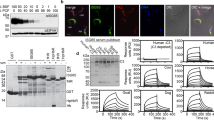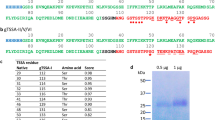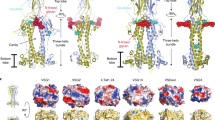Abstract
African trypanosomes are parasitic protozoa which are enveloped by a surface coat consisting of a matrix of identical glycoprotein molecules1. Variations in the composition of these variant surface glycoproteins (VSGs) allow the parasite to escape the host's immune system and render effective immunoprophylaxis improbable2–5. However, underlying the surface coat, all variant antigen types contain common membrane components6, some of which can activate complement by the alternative pathway7, leading to lysis of uncoated trypanosomes. Hence, stimulation of VSG release in vivo should be a potential form of chemotherapy, and we have therefore investigated the mode of attachment of VSG to the plasma membrane. Biochemical characterization of VSGs from several species has been performed on material purified after release from the cell surface following rupture of the trypanosome8–11. We demonstrate here that VSGs of Trypanosoma brucei when bound to the membrane exist in a form which differs both biochemically and immunochemically from VSGs purified in the conventional manner. After rupture of the cell, membrane-form VSG (mfVSG) is enzymatically transformed into the commonly isolated water-soluble released form (sVSG). In conditions in which this modification does not take place, purified VSGs have amphiphilic properties and behave as integral membrane proteins by the criterion of charge-shift electrophoresis. The difference between the two forms lies in the C-terminal domain, which is phosphorylated in both forms. This domain in sVSGs contains an immunogenic oligosaccharide known as the cross-reacting determinant (CRD), attached to the C-terminal amino acid12. Recognition of this determinant by anti-CRD antibodies is impaired in the membrane form.
This is a preview of subscription content, access via your institution
Access options
Subscribe to this journal
Receive 51 print issues and online access
$199.00 per year
only $3.90 per issue
Buy this article
- Purchase on Springer Link
- Instant access to full article PDF
Prices may be subject to local taxes which are calculated during checkout
Similar content being viewed by others
References
Vickerman, K. J. Cell Sci. 5, 163–193 (1969).
Vickerman, K. Nature 273, 613–617 (1978).
Turner, M. J. Adv. Parasit. 21, 69–153 (1982).
Englund, P. T., Hajduk, S. L. & Marini, J. C. A. Rev. Biochem. 51, 695–726 (1982).
Borst, P. & Cross, G. A. M. Cell 29, 291–303 (1982).
Seed, J. R. Parasitology 54, 593–596 (1964).
Tetley, L., Vickerman, K. & Moloo, S. K. Trans. R. Soc. Trop. Med. Hyg. 75, 409–414 (1981).
Cross, G. A. M. Parasitology 71, 393–417 (1975).
Olenick, J. G., Travis, R. W. & Garson, S. Molec. Biochem. Parasit. 3, 227–238 (1981).
Baltz, T. et al. FEBS Lett. 82, 93–96 (1977).
Reinwald, E., Rautenberg, P. & Risse, H. J. Biochim. biophys. Acta 668, 119–131 (1981).
Holder, A. A. & Cross, G. A. M. Molec. Biochem. Parasit. 2, 135–150 (1981).
Rovis, L., Barbet, A. F. & Williams, R. O. Nature 271, 654–656 (19878).
Bowles, D. J. & Voorheis, H. P. FEBS Lett. 139, 17–21 (1982).
Voorheis, H. P., Bowles, D. J. & Smith, G. A. J. biol. Chem. 257, 2300–2304 (1982).
Helenius, A. & Simons, K. Proc. natn. Acad. Sci. U.S.A. 74, 524–532 (1977).
Parkhouse, R. M. E., Lifter, J. & Choi, Y. S. Nature 284, 280–281 (1980).
Boothroyd, J. C., Cross, G. A. M., Hoiejmakers, J. H. J. & Borst, P. Nature 288, 624–626 (1980).
Matthysens, G., Michiels, F., Hamers, R., Pays, E. & Steinert, M. Nature 293, 230–233 (1981).
Rice-Ficht, A. C., Chen, K. K. & Donelson, J. E. Nature 294, 53–57 (1981).
McConnell, J., Turner, M. J. & Rovis, L. Molec. Biochem. Parasit. (in the press).
Holder, A. A. Biochem. J. 209, 261–262 (1983).
McConnell, J., Gurnett, A. M., Cordingley, J. S., Walker, J. E. & Turner, M. J. Molec. Biochem. Parasit. 4, 225–242 (1981).
Laemmli, U. K. Nature 227, 680–685 (1970).
Towbin, H., Staehlin, T. & Gordon, J. Proc. natn. Acad. Sci. U.S.A. 76, 4350–4354 (1979).
Cross, E. Meth. Enzym. 11, 238–255 (1967).
Kessler, S. W. J. Immun. 115, 1617–1624 (1975).
Author information
Authors and Affiliations
Rights and permissions
About this article
Cite this article
de Almeida, M., Turner, M. The membrane form of variant surface glycoproteins of Trypanosoma brucei. Nature 302, 349–352 (1983). https://doi.org/10.1038/302349a0
Received:
Accepted:
Issue Date:
DOI: https://doi.org/10.1038/302349a0
This article is cited by
-
Trans-sialidase Protein as a Potential Serological Marker for African Trypanosomiasis
The Protein Journal (2019)
-
Structural basis for the shielding function of the dynamic trypanosome variant surface glycoprotein coat
Nature Microbiology (2017)
-
Distinct donor and acceptor specificities of Trypanosoma brucei oligosaccharyltransferases
The EMBO Journal (2009)
-
Failure of immunization with trypanosome endocytotic vesicle membrane proteins to provide nonvariant immunoprotection againstTrypanosoma brucei
Parasitology Research (1994)
-
Induction of the proteolytic activity of a membrane protein in Plasmodium falciparum by phosphatidyl inositol-specific phospholipase C
Nature (1988)
Comments
By submitting a comment you agree to abide by our Terms and Community Guidelines. If you find something abusive or that does not comply with our terms or guidelines please flag it as inappropriate.



